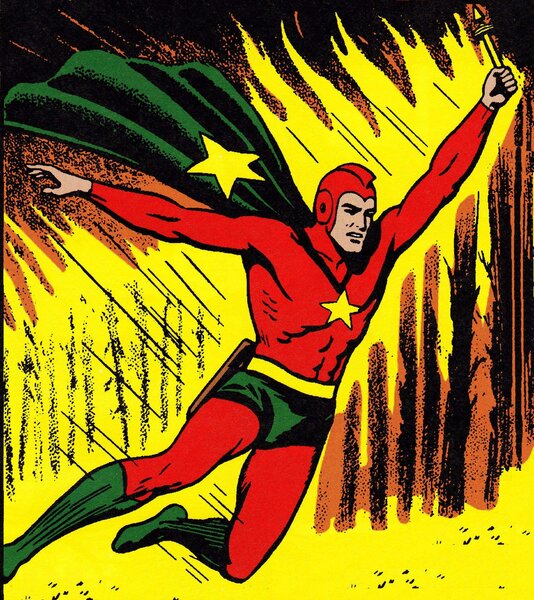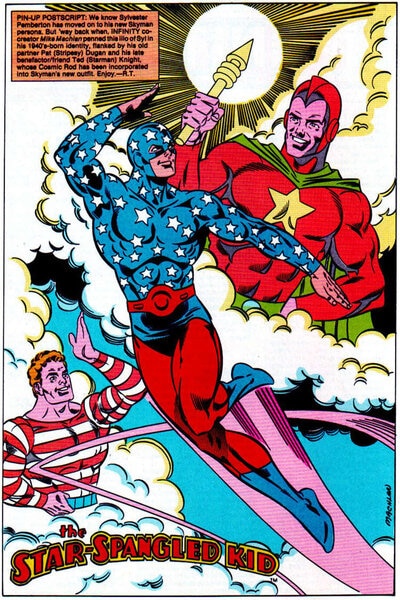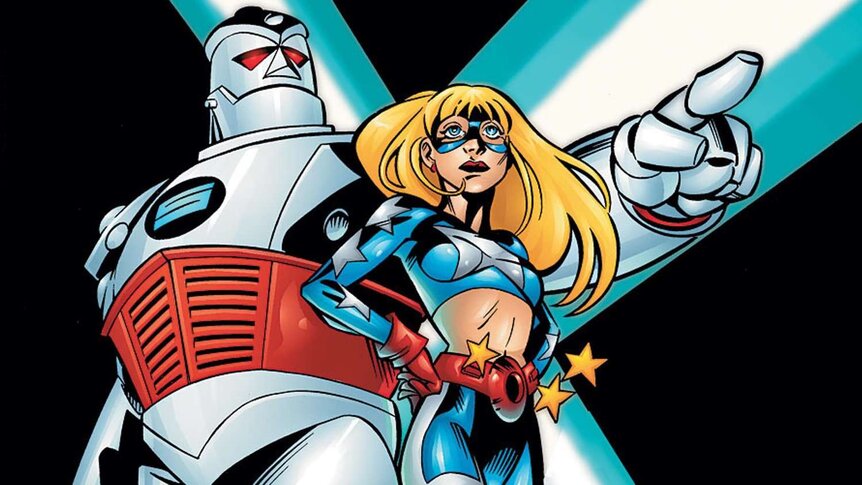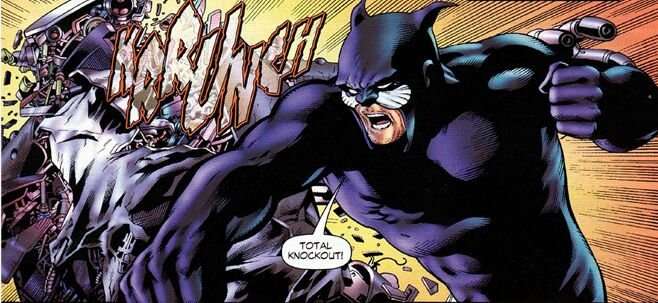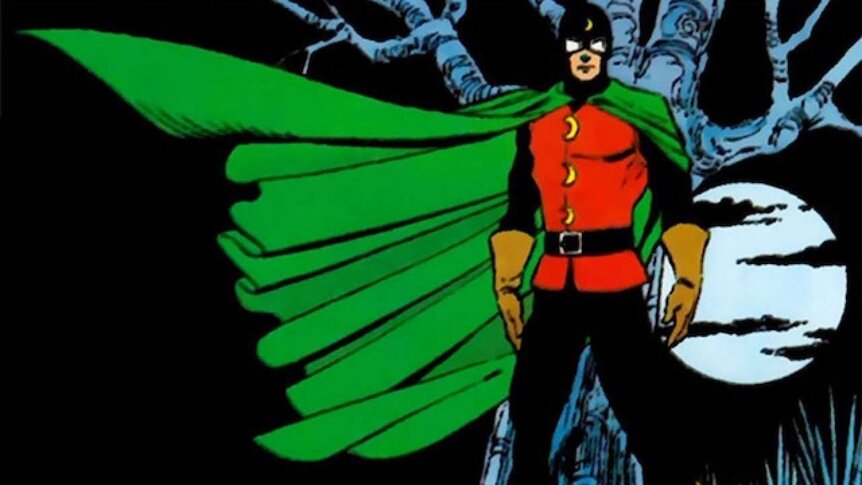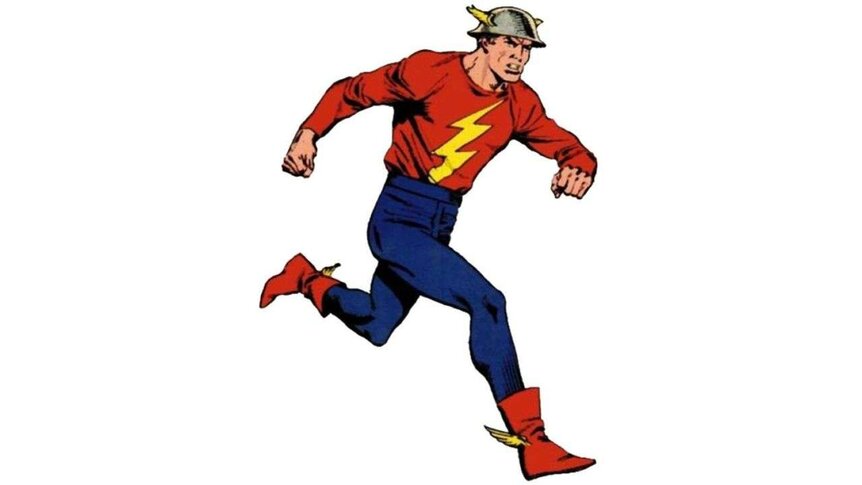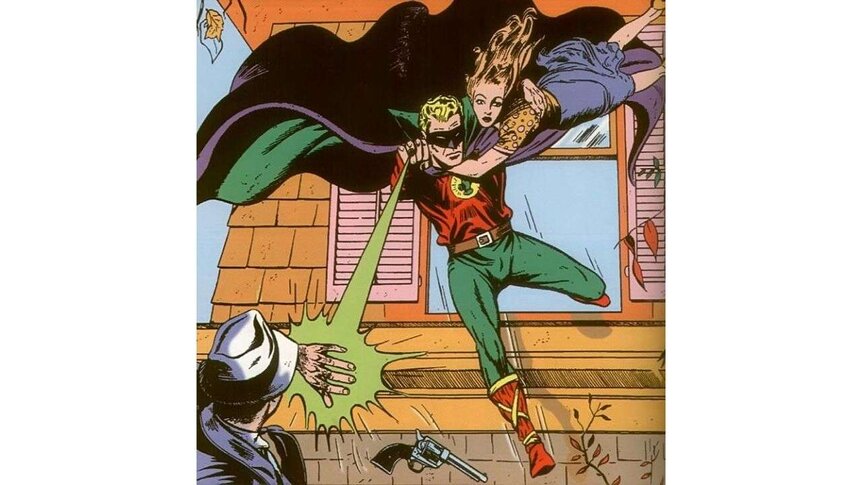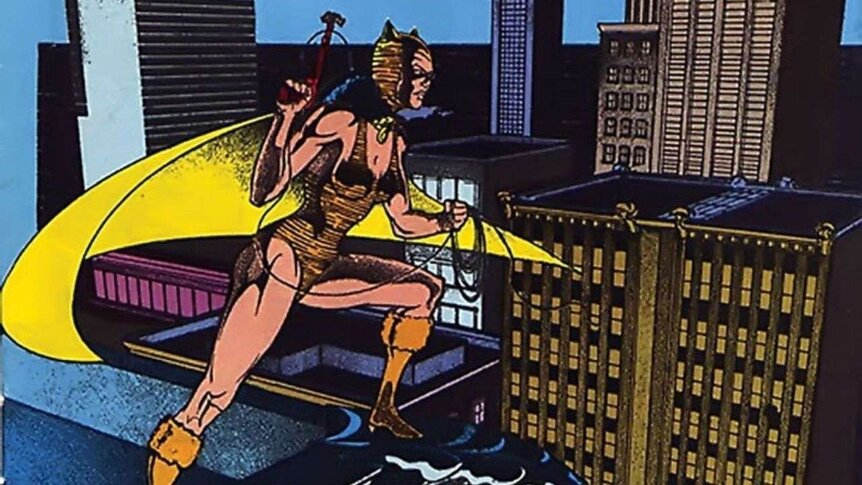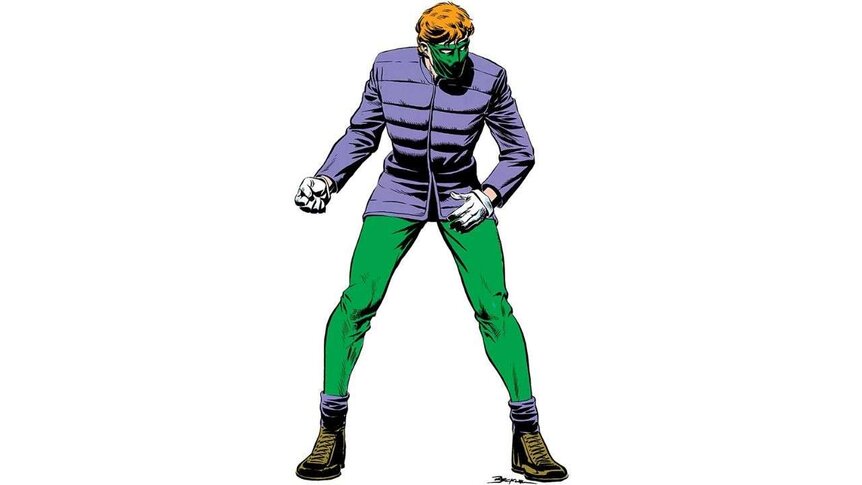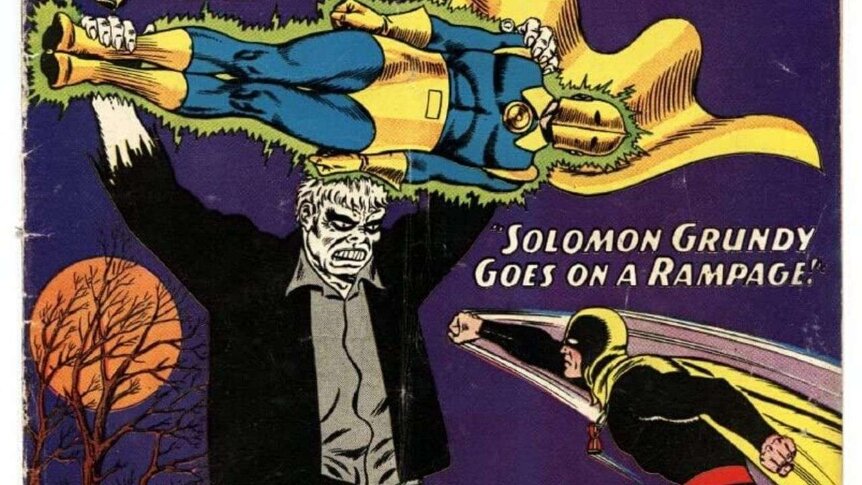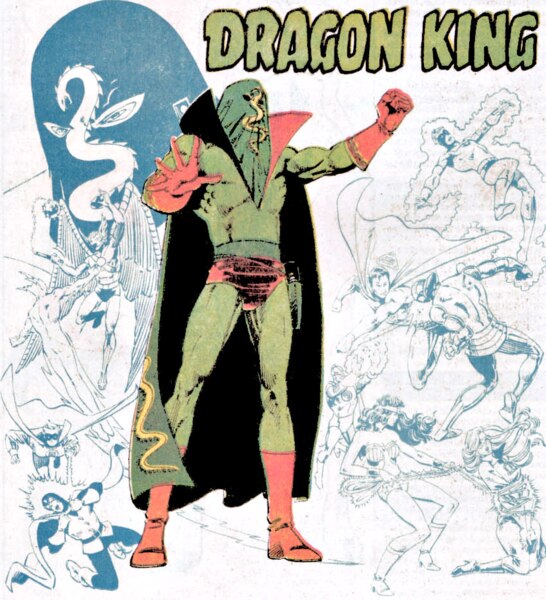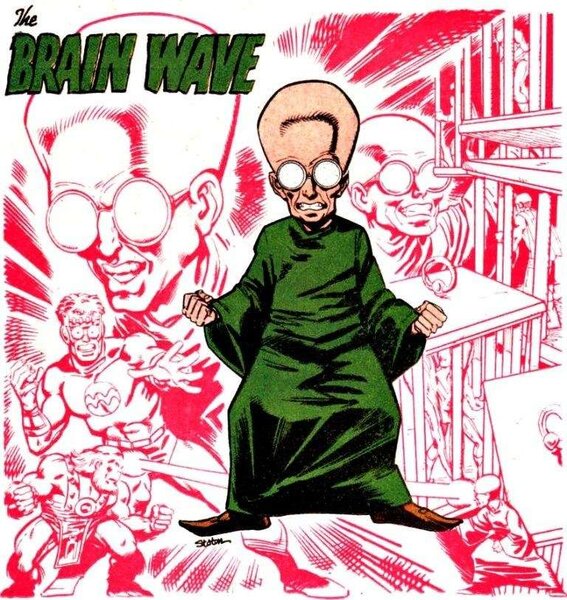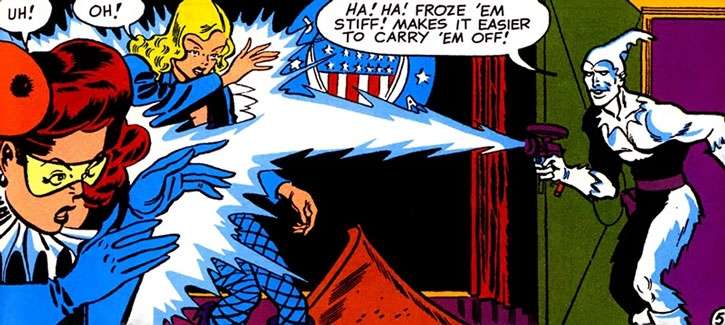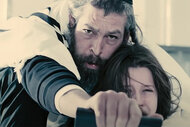Create a free profile to get unlimited access to exclusive videos, sweepstakes, and more!
The Golden Age comic book origins of the heroes and villains of Stargirl

Stargirl, The CW's latest superhero show, might be based in the present day, but its characters' origins go back to Starman comics from the 1940s. In fact, the first six minutes of the premiere features several Golden Age heroes and villains. The first character we see is Pat "Stripesy" Dugan (Luke Wilson), racing to give backup to Starman himself, Sylvester Pemberton (Joel McHale). The two heroes, along with their Justice Society of America teammates, are knee-deep in a fight with the Injustice Society, aka the Legion of Doom.
Almost every character in the first fight scene has an origin story developed at a time when comics in America were popular because of World War II. Comic pages were filled with pro-war, anti-Nazi storylines, and some of the heroes who fought the good fight endure to this day. Although Stargirl updates and alters things a bit, we thought we'd give you a little comic book history lesson and introduce you to some of the oldest characters in the DC Comics canon.
Warning: This story contains major spoilers for Stargirl.
Starman, the Star-Spangled Kid, and Stripesy
The first Starman appeared in 1941 in Adventure Comics #61 when Ted Knight, an astronomer, invented a "Cosmic Rod" that allowed him to fly and manipulate energy. Knight went on to fight crime (and a few Nazis during WWII) with the JSA. When Ted retired, his son Jack modified his father's weapon, renamed it the "Cosmic Staff," and became the next Starman.
Sylvester Pemberton, however, was first known as The Star-Spangled Kid, a teenaged vigilante hero who debuted with his sidekick Stripesy (Pat Dugan, the family mechanic and chauffeur who would always accompany his young charge) in 1946. Although the pair is credited with first being seen in Star Spangled Comics #1, technically, their debut was in Action Comics #40, when a teen Pemberton and Dugan quelled a riot some Nazi sympathizers started at a movie theater. Pemberton came from a life of wealth and privilege and was well-trained in acrobatics and hand-to-hand combat.
Since Kid's costume featured a star on his chest and Stripesy always wore a striped shirt, the pair became the living embodiment of the American flag. What made the team-up different from any other superhero duo was that Pemberton was a child with an adult sidekick.
Neither had superpowers, but the Star-Spangled Kid did have a "Cosmic Converter Belt" that was derived from Ted Knight's original "Cosmic Rod" Tech.
S.T.R.I.P.E. and Stargirl
In 1999, Geoff Johns wrote an updated comic book series called Stars and S.T.R.I.P.E. featuring a new Star-Spangled Kid named Courtney Whitmore. She was the stepdaughter of Pat Dugan, who invented and powered the Special Tactics Robotic Integrated Power Enhancer (S.T.R.I.P.E.) to protect her.
Courtney donned an updated version of the Star-Spangled Kid’s outfit and the Cosmic Converter Belt, and eventually obtains the Cosmic Staff when Jack Knight, the Starman in this universe, retires from super-heroics. Before she joined the JSA, Courtney changed her name to Stargirl and utilized both the belt and the staff, preserving the legacy of both Starman and the Star-Spangled Kid. (In the CW show, it is hinted that Pemberton might actually be Courtney's father.)
Wildcat — Ted Grant
Ted Grant gets taken out pretty quickly in Stargirl's first fight scene, but he has a pretty interesting origin story. First appearing in Sensation Comics #1 (1942) alongside Wonder Woman, Grant was a championship boxer who was framed for the death of one of his opponents. He’s framed again for the deaths of two police officers after his false arrest. Grant took on the mantle of Wildcat after being inspired by a story about the Green Lantern (Hal Jordan) and went on to both clear his name and live the life of a vigilante.
Hourman — Rex Tyler
There have been several Hourmen in DC Comics history, but Rex Tyler was the first and a founding member of the JSA.
He first appeared in Adventure Comics #48 (1940). A biochemist who was a bit obsessed with hacking the human genome and pushing the limits of the human body, Rex developed a miracle vitamin which he dubs "Miraclo." The drug gives him superhuman strength, speed, and healing ability. But... only for one hour a day.
In The CW's show, Rex is the first person that we see inside the mansion fighting Tigress.
Dr. Mid-Nite — Doctor Charles McNider
Doctor Charles McNider first appeared in 1941 in All-American Comics #25. He was severely injured while performing surgery on a shooting victim when a hitman threw a grenade into the surgery theater. Everyone died except for McNider, who was badly injured and blinded by debris. During his recovery, he trained intensively to hone his other senses to compensate for the loss of his sight.
One evening, someone threw a wooden owl statue through McNider’s window and he realized that he could see perfectly... at night. In the show, Dr. Mid-Nite is also defeated in the opening scene when what looks like Solomon Grundy's giant hand appears to crush him.
The Flash — Jay Garrick
Garrick didn’t physically appear during that opening fight scene. But, there was evidence he was there. A winged helmet appears on the floor amidst debris covered in ice, which probably means that The Flash met an untimely end in this universe at the hands of Icicle.
Modern superhero fans might be familiar with Jay Garrick from The Flash CW show, although that version of the hero also met an untimely en during the Arrowverse’s Crisis on Infinite Earths season finale.
Jay, the original Flash, first appeared in his Flash Comics #1 (1940), but unlike Barry Allen, he did not get his powers from a lightning strike. Instead, Garrick’s powers came from inhaling heavy water vapor fumes when he fell asleep in his lab. (Superhero science, folks.)
Green Lantern — Alan Scott
Green Lantern, another founding member of the JSA, is likely present in the CW show’s opening scene, but we never see his face. Instead, it’s only the glow of his power ring in the first scene. Since this show is chock full of Golden Age Heroes, we’re going to assume that it’s Alan Scott (although that has not been confirmed). See Alan Scott first appeared in All-American Comics #16 (1940) as a young railroad engineer who happened to be on board a train with one of the original pieces of the Starheart, a powerful magic bound by the Guardians of the Universe. The train crashed when it passed over a collapsing bridge, but Scott survived by grabbing the lantern. The device communicates with him to create a ring out of metal from its base. Scott powers the ring with the Starheart and his literal will to use its abilities for good.
Tigress - Paula Brooks
Although Paula Brooks' first appearance in the comics was in Sensation Comics #68 (1947), after the Crisis on Infinite Earths (1985), most of her history was rebooted. The Post-Crisis Paula first appeared in Young All-Stars #6 (1987), but she wasn't a villain. In fact, the former cat burglar-turned-hero fought Nazis just like Starman did.
But, during a fight with Axis Amerika (more Nazis), she was taken out by a Valkyrie. She's revived, but was never quite the same, which led to her turn to the dark side, changing her name to Huntress and joining the Injustice Society. Tigress was a skilled fighter and weapons expert, but had no superpowers to speak of.
Sportsmaster — Lawrence "Crusher" Crock
Lawrence Crock was a professional athlete who had little regard for the safety of either his teammates or his opponents. Crock first appeared in All-American Comics #85 (1947). Fiercely competitive, he played both football and hockey, and after brutally paralyzing another player, he was banned from sports.
In a drunken rage, he decided to form a team of villains made up of other former athletes and set out to rob a bank, but Green Lantern and his sidekick Dolby Dickles foil his plan. Post-Crisis, Sportsmaster joined the Injustice Society, meets and marries Tigress, and starts a family. (Their child Artemis is a major character in the Young Justice animated series.)
In Stargirl, Sportsmaster can be seen briefly at the end of the fight standing next to Tigress (and later as the gym owner up the street from Dugan's garage).
Solomon Grundy
Solomon Grundy has worked his way around the DC Comics Rogues' Gallery. In the CW show, he is the huge monster of a man who busts out of the door and does damage to Dugan's Star Rocket Racer while the hero and Starman are trying to get away.
Grundy was born Cyrus Gold, and in life was a wealthy merchant of ill repute who was killed and left for dead in Slaughter Swamp near Gotham. Some 50 years later, he was reanimated, somehow, and parts of his body had actually become part of the swamp. Most iterations of Grundy give him basic intelligence, incredible strength, and a hulking temper.
Dragon King — Dr. Ito
The man in the first scene who looks like the green version of Watchmen's Hooded Justice is none other than the Dragon King. Dr. Ito, who first appeared in All-Star Squadron #4 (1981), was a member of Japan's Black Dragon Society. The evil scientist combined the powers of the Holy Grail (on loan from the Nazis) and the Spear of Destiny to create a magical shield to protect the Axis Powers from the JSA during WWII. (This explains why the superheroes didn't just stop the war when they had the chance.)
Later, he retired and moved to the U.S., to Blue Valley, Idaho, to raise his daughter Cindy Berman, who would eventually become the supervillain Shiv.
Brainwave — Henry King
First appearing in All-Star Comics #15 (1943), Henry King was the first of many characters to use the moniker Brainwave and one of the founding members of the Injustice Society. Born with psionic abilities, he studied psychiatry and trained his mental capabilities to include image projection, telepathy, telekinesis, and psionic energy blasts.
When he died, his son, Henry King Jr., who had developed psychic abilities of his own, inherited his father's powers of image projection and psionic blasts.
Icicle — Joar Mahkent
Joar Mahkent has powers of ice manipulation and a "cold gun" that could freeze liquid molecules in his vicinity — including ones inside the human body.
When Mahkent first appears, in the pages of All-American Comics #90 (1948), Alan Scott thinks he’s dead — with good reason. There's a ship docked in Gotham Harbor that's frozen solid and what appears to be Mahkent's corpse in his quarters. Scott soon learns the truth, though: that the dead man on the ship was a gangster and rival of Mahkent's. Mahkent’s prolonged exposure to the cold gun affected his DNA and his son Cameron inherits cryogenic powers... without the need for a weapon.
Icicle, for the record, was around way before Captain Cold.
